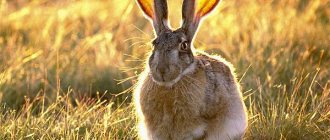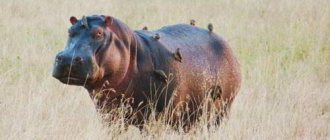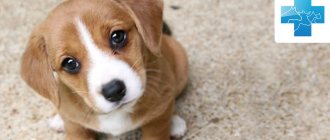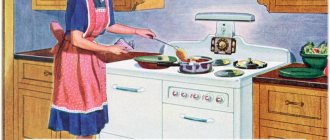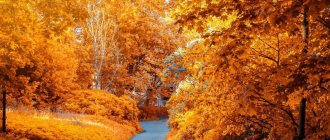4
Average rating: 4
Total ratings received: 68.
4
Average rating: 4
Total ratings received: 68.
All mammals are born small and defenseless. In the wild, adult animals protect babies. A person takes care of domestic animals and protects them from dangers. Baby animals have a special diminutive name. In some cases, the names of the animals and their babies are different and should be remembered, and sometimes the names are similar.
What are baby pets called?
The names of the children of most pets are well known. The children of a goat are kids, the children of a pig are called piglets, the child of a dog is called a puppy, the child of a camel is born a baby camel, and the child of a cat is a kitten. Turkeys and ducks hatch eggs, which hatch into turkey poults and ducklings. And a newborn donkey is called a foal.
Rice. 1. Baby camel.
Kittens and puppies are born blind and deaf. Kittens are able to see 5–10 days after birth, and hear after 9–11 days. Puppies take about 3 weeks to see and hear their family.
Calf
This is the name of all artiodactyl cubs. Calves are born not only to cows, but also to bison, giraffes, moose, hippopotamuses, camels, deer, rams, and gazelles. Pigs, sheep and goats are also artiodactyls, but the offspring are usually called piglets, lambs and kids, respectively. Baby reindeer have special names. Up to a month old babies are called fawns. It was from their fur that fawn hats were made. From a month to a year, small fawns are called neblyu. It is curious that the mother of a fawn is called an important woman, and the mother of a red fawn is called a deer or lanka.
It may seem surprising, but baby whales, narwhals, dolphins, and killer whales are also called calves. Despite the fact that cetaceans do not have hooves, they are classified as artiodactyls, or scientifically called cetaceans. Whales evolved from ungulate predators - mesonychians. These animals lived approximately 60 million years ago and resembled wolves, but with hooves. It is assumed that their main food was fish. Mesonychia dived for prey and gradually, in the process of evolution, switched to an aquatic lifestyle. Modern whales and artiodactyls have similar skeletal structures. In colloquial speech, a baby whale can be called a baby whale, and dolphins can be called a baby dolphin.
Baby wild animals
The names of the cubs of many wild animals are similar to the names of domestic babies.
Tigers, cheetahs, pumas, lynxes, jaguars belong to the cat family. Their children are called kittens, for example, a lynx kitten.
Foxes, wolves, jackals are relatives of dogs. Dog cubs are called puppies, that is, a wolf baby will be called a wolf pup. The name wolf cub and fox cub are also correct.
There are names that repeat the name of the parents: lion cub, tiger cub, elephant calf, kangaroo cub, bear cub, deer cub.
Puppy
All canid cubs are called puppies. In addition to dogs, these include arctic foxes, sables, foxes, raccoons, wolves, martens, and hyena dogs. Puppies are also born from pinnipeds (walruses, seals, fur seals, seals), skunks, otters and bats. Pinnipeds are canids and are distant relatives of dogs and bears. In fact, cubs can also be called puppies. Skunks and otters are relatives of martens. It is difficult to say why baby bats were also called puppies. But these animals are perhaps one of the most mysterious mammals, as they are difficult to observe.
Giraffe
Giraffes have a memorable appearance - a long neck, horns, eyes with long eyelashes. Each giraffe has an individual pattern on its skin. Animals run and jump well, but cannot swim. The giraffe has excellent eyesight; it can see its fellow tribesmen at a distance of 1 km.
What is the name of a baby giraffe? The giraffe is a distant relative of cows, which is why its baby is called a calf. In modern dictionaries there is the option “giraffe”.
Rice. 2. Baby giraffe.
Foal
Everyone knows that horses give birth to foals. However, this name applies to all equid animals. These include zebras, donkeys, and tapirs. These animals do not have double hooves, like goats, giraffes, and buffaloes.
Rhinos are an exception. This animal is also an equid, but its offspring are usually called calves. In the scientific literature, a simple name is also often found - a baby rhinoceros. In colloquial speech, baby rhinoceroses may be called rhinoceroses or rhinoceroses.
Zebra
Zebras are related to horses and behave like horses - they run, jump, chew grass, and live in large herds. A baby zebra is called a foal. The baby stands on its feet soon after birth and can run after its mother within an hour. The pattern on the zebra's body is unique, and the baby recognizes its mother by it.
In 2022, a small zebra with a brown coat and white spots was discovered in Kenya. It turned out that the baby was deficient in a substance that is responsible for proper coloring. The herd adopted an unusual baby.
Rice. 3. Spotted baby zebra.
Baby animals
Let's start with pets. They catch the eye of children more often, and therefore arouse greater interest.
Sheep
Let's look at what a baby sheep is called. Many people living in cities do not even realize that sheep and ram are one type of animal, only female and male. Their baby is not called a ewe or lamb, but a lamb.
This is interesting! The word lamb comes from the Latin agnus. In the Old Church Slavonic language, a baby sheep and ram sounds like a lamb. The name of the animal contained the root “yagn”. Later, the suffix “enok” was added to it, which denotes a reduced form. Hence the name - lamb.
Pig
Pigs are one of the first animals to be domesticated by humans. They belong to the order Artiodactyls. They supply people with meat and lard. The female pig is called a sow or pig, and the male is called a boar or boar. But their baby is called not a pig or a hog, but a piglet.
This is interesting! The Slavs called a male pig a poros. The addition of the suffix “enok”, again, means a reduced form. Hence the name - piglet.
By the way, the birth of piglets is called farrowing, and a pregnant pig is called gestation.
Cow
Cows have been tamed by humans since ancient times. They give people meat and milk. The male cow is called a bull, and the baby is called a calf. Another example of the fact that children and parents have different roots.
Experts still cannot figure out where the word calf came from; there are only guesses. One of them is that among the ancient Slavs this word meant “born”, but cows bear their offspring for 9 months.
Turkey
America is the homeland of turkeys. But in recent centuries, this bird has been grown in European countries.
This is interesting! Few people know that turkeys are named after their homeland. Previously, America was called the West Indies, so the name of the birds is translated as Indian rooster.
In this case, parents and their children have the same root. A female turkey is called a gobbler or turkey, and her baby is called a poult.
Rabbit
Another domestic animal is the rabbit. The female is called a rabbit, the male is called a rabbit, and their baby is called a bunny.
Rabbits are raised for meat, hides and fur. The Angora breed of animals has valuable fur; beautiful and expensive fur coats are made from it.
Scientists also test drugs on rabbits before releasing them for sale. Not long ago, dwarf breeds of rabbits were bred; now they are kept in apartments instead of hamsters and guinea pigs.
Goats
Unlike previous animals, goats are not so often raised by people, but there are entire farms with them. The fact is that in addition to meat and fatty milk, these animals provide people with skin and wool.
The female of these animals is a goat, the male is a goat, and their baby is a kid. The baby’s name still contains the same “diminutive” suffix “enok”.
Many people confuse kids with lambs. This is a big misconception because we are talking about two different species of animals.
Horses
Horses were domesticated more than 7,000 years ago. During this time, people developed many breeds of these animals, from miniature ponies to huge draft horses and horses.
A female horse is called a mare, a male is called a stallion or horse, and their baby is called a foal. If we are talking about two or more babies, then the word foals is used.
Speaking in general about this type of animal, two names are applied to them: horses and steeds.
Ducks
Ducks can be wild or domestic. They belong to the order of birds and are valued for the taste of their meat. The female of these birds is called a duck, mallard, the male is called a drake, and their baby is called a duckling. If we are talking about two or more chicks, then the word ducklings is used.
We looked at domestic animals, but there are many more wild and tropical animals, as well as fish and birds, that are of interest to children and adults.
Very often children ask: what is the name of a baby zebra or giraffe? But not every adult will immediately answer this question.
Zebras
Zebras belong to the order of equids. In fact, these are the same horses, only with a characteristic black and white coloring. In common parlance, zebra cubs are called baby zebras or baby zebras, but this is an incorrect endearing interpretation. The correct name is foal, just like horses.
Giraffe
Since giraffes are the tallest animals in the world, interest in this animal is high. With their participation, many cartoons were shot, various stories and fairy tales were invented. It is not surprising that children are interested in the question: what is the name of a baby giraffe?
Since these representatives of the fauna belong to the order of artiodactyls, their babies are called calves. However, this name was not strongly attached to the offspring of giraffes. They are more often called giraffes or giraffes. But if a child is given the task of describing baby giraffes, then the correct word would be a calf.
By the way, a female giraffe is called a giraffe, and a male is called a giraffe.
Summary of educational activities in the 1st junior group "Wild and domestic animals and their young"
Municipal budgetary preschool educational institution
"Kindergarten No. 3"
Summary of OOD on speech development in the first junior group
"Pets
and their young"
Conducted by: teacher
Muftalieva R.Z.
Makhachkala
2016
Summary of direct educational activities on speech development in the first junior group
"Domestic Animals and Their Young"
Target:
consolidate and expand children's knowledge about domestic animals and their cubs.
Tasks:
- Educational:
- learn to name and compare animals by size - “big” - “small”; contribute to the development of sound expressiveness of speech, the pronunciation of onomatopoeia “loud” - “quiet”.
- Developmental:
- develop the articulatory apparatus; contribute to the development and enrichment of children's active vocabulary (dog-barks, cow-moos; horse-clops); consolidate children’s ability to assemble puzzles (adult animal-cub), putting parts together to find the correct way to connect them; develop mental processes (imagination, memory, attention.)
3. Educational:
cultivate the ability to listen to the teacher attentively and not be distracted; instill love and respect for animals; form friendly relationships between children; foster interest in activities and create a joyful mood in children.
Equipment:
toys - cat, dog, cow, horse; subject paintings from the series “pets and their cubs”; handout puzzles “Who has what kind of mother?”; cap, scarf; treat - apples.
Progress of educational activities:
I. Introductory part.
- Guys, look, guests have come to us. Let's say hello to them!
- Now, let's say hello to each other. We smiled at each other, we smiled at the guests.
Hello pens! Clap-clap-clap! Hello legs! Top-top-top!
Hello cheeks! Plop-plop-plop!
Chubby cheeks? Plop-plop-plop!
Hello, little eyes! Blink-blink-blink!
Hello sponges! Smack-smack-smack! Hello, my nose! Beep-beep-beep!
Hello kids! One two Three. Girls and boys!
Surprise moment.
- Guys, hear someone knocking on the door. Yes, this is the postman Pechkin, he brought us a telegram. What is written in it? I’m reading “Dear children, I invite you to my village, come, I’ll be waiting!” Grandma Nina.
-Guys, let's go to Grandma Nina by bus! Take your seats!
Forward, forward the bus, spin the wheels!
Hurry, hurry, driver, start your engine!
The teacher puts on a cap and takes the steering wheel in his hand.
-Look guys, I've turned into a driver.
A fragment of the song “We are going, we are going, we are going...”
-So we came to grandma Patimat in the village, come in and sit on the chairs.
II. Main part.
1. Articulation gymnastics:
-Guys, now we will prepare our mouths for conversation.
"Smile":
They pulled their lips towards their ears and smiled like frogs.
"Proboscis":
We squeeze the sponges into a tube, and we get a proboscis.
"Delicious jam":
lick your lips with your tongue.
2. Conversation about domestic animals and their babies.
The teacher puts a scarf on his shoulders.
- Hello guys, girls and boys. I am very glad that you came to visit me, how did you get there? Fine? But I don’t live alone in the village, and I want to introduce you to the animals that live next to me.
I'll tell you a riddle, and you guess who it is. (As you guess, animal toys are laid out on the table one by one).
- “Who grazes in the meadow and screams a long mu-u-u?” (Cow).
Early in the morning the shepherd boy “turu-ru-ru”,
Vlad’s akorovki muttered “moo-oo-oo-oo” to him.
You, Burenushka, go and take a walk in the open field,
And when you come back in the evening, you’ll give us milk to drink!
- “Long mane, jumps zealously, hard hooves, give me some water to drink.” Who is this? (Horse).
I love my horse, I comb its fur smoothly,
I’ll comb my ponytail and go on horseback to visit!
- “The muzzle is mustachioed, the fur is striped, it washes itself often, but is not familiar with water.” Who is this? (Cat).
The pussy came up to the kids and asked for milk,
The milk asked for milk and said “meow”.
- “He is friends with the owner, guards the house, lives under the porch, tail in a ring.” Who is this? (Dog).
Here is the dog, Bug, with a squiggle tail,
The teeth are sharp, the fur is motley, “woof-woof-woof!”
- Well done, guys, you guessed the pets. Now let's look at the pictures. (Show pictures with adult animals and their babies alternately).
-Who is that in the picture? … Right! Cow. And next to her is her baby - a calf. Who is this, repeat? - “Cow and calf.”
The cow is big and moos loudly: “Mu...”, and the calf is small and mooes quietly: “Mu...” (children repeat the onomatopoeia quietly and loudly). The cow has horns and is butting. The calf has no horns and has not yet grown.
(The teacher shows the following picture)
- Look, children, who is drawn in this picture?... That's right, a horse. And next to her is her baby - a foal. Who is this, repeat? - “A horse with a foal.” The horse is big and shouts loudly: “Yoke - go...”. And the little calf screams quietly: “Igo - go...” (children repeat). The horse is beautiful, with a thick mane and a long tail. The foal is small and has thin legs. (The teacher shows the following picture).
- Who is drawn in this picture?... That's right, a dog. And next to her are her cubs - puppies. Who is this, repeat? - “Dog with puppies.” The dog is big and the puppies are small. The dog barks loudly: “Woof - woof,” and the puppies quietly: “Woof – woof.” (Children repeat) The dog is big, guards the owner’s house, loves to chew on a bone. And the puppies are small, love to run, drink milk. (The teacher shows the following picture).
- Who is drawn in this picture?... That's right, a cat. And next to her are her cubs - kittens. Who is this, repeat? - “Cat with kittens.” The cat is big, and the kittens are small. The cat meows loudly: “Meow...”, and the kittens quietly: “Meow...”. (children repeat). The cat is big, beautiful, fluffy, loves to lick its fur with its tongue. And the kitten is small, fluffy, and loves to play with balls of thread.
- Guys, adult animals take care of their young - they feed them milk, clean their fur with their tongues, protect them, and keep them warm. Repeat, guys, how animals take care of their babies. (children repeat).
“Children, you’re tired of sitting on chairs, let’s move around and play the game “Stompers.”
We stomp our feet, we clap our hands, we shake our heads,
We raise our hands, we lower our hands and then spin around.
III. Fastening:
1. Didactic game.
-Grandmother Patimat has a game “Who has what kind of mother?” - these are pictures depicting domestic animals and their cubs. It's just that their parts are mixed up. Let's connect the parts of the pictures and name the mothers and their babies.
(Children, with the help of the teacher, collect pictures).
-Well done guys! And because you came to visit me and did so well, I will give you apples from my garden!
- It's time for us to go to kindergarten. How did we arrive to grandma Patimat? (on the bus) Take your seats! Go!
A fragment of the song “We are going, we are going, we are going...”
3. Final conversation.
-Where did we go today?
- Who invited you to the village?
— What are the names of the cubs of a cat, dog, cow, horse?
Well done!

